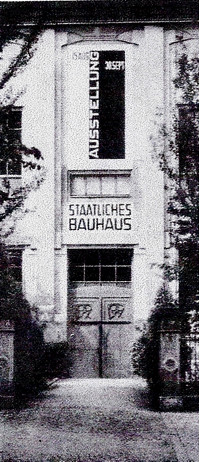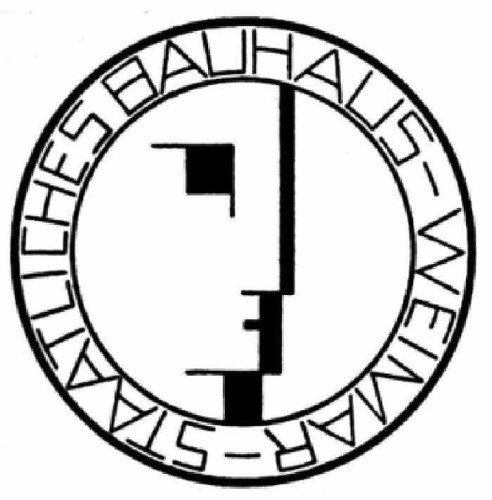Thursday, 7:00am
26 September 2013
High-priced ephemera
A unique version of Joost Schmidt’s iconic Bauhaus poster may reach a record price at auction. By Graham Twemlow

One year after its blockbuster sale ‘Posters with a Purpose: the London Transport Museum Sale’ (see ‘The purpose of posters’ on the Eye blog) Christie’s South Kensington are staging another one-off poster sale.
The sale, which Christie’s has grandly titled: ‘Graphic Masterworks: A Century of Design’ is predominantly made up of posters but also includes some rare sets of early twentieth century avant-garde periodicals, including a complete set of Wendingen (‘Turning Points’) – “one of the most influential art journals of its time…” and eighteen issues of Broom: An International Magazine of the Arts with cover designs by El Lissitzky, Man Ray, Moholy-Nagy and Goncharova.
Broom: An International Magazine of the Arts, 1923. Cover design: El Lissitzky.
Top: Joost Schmidt, Staatliches Bauhaus Ausstellung, poster, (68.5 x 48 cm), 1923.

Broom: An International Magazine of the Arts, Vol. 1 No. 3, 1922. Cover design: Fernand Léger.

All of the 109 lots in the sale come from the Dutch poster collector Martijn Le Coultre who amassed a vast collection of posters over a 38-year period. Le Coultre claims that many of the posters in this sale rarely come on to the open market. In particular he believes that his version of Joost Schmidt’s widely known poster Staatliches Bauhaus Ausstellung, produced to advertise the Bauhaus’ milestone exhibition of 1923, is the only known copy of its kind.
The exhibition, which celebrated four years of work produced by staff and students of the Weimar Bauhaus since its opening in 1919, was displayed in the main building, the workshops, the classrooms and the State Museum of Weimar. It was a huge public relations success with fifteen thousand visitors attending.
Entrance to the 1923 exhibition. Signage above door by Herbert Bayer.

In 1923 Schmidt was a mature student at the Bauhaus and it is claimed that his poster design was the winning outcome of a competition. He has incorporated Oskar Schlemmer’s minimalist Bauhaus emblem (although interestingly he reverses it) into his stark geometric design. The strategically placed lettering is dynamic in style but it is odd that there is no information relating to the details of the exhibition – place, opening days and times.
Oskar Schlemmer, Bauhaus emblem, 1922
 In the version on sale at Christie’s a crudely stencilled calendar date ‘25’ has been added.
In the version on sale at Christie’s a crudely stencilled calendar date ‘25’ has been added.
Le Coultre writes: ‘The example offered here shows the original proposed date of 25 July (the figure 25 was stencilled on after the lithographic process). It originated from the collection of Dr Adolf Behne … It is the only known copy that was not altered with the revised date.
‘When, after several postponements, the exhibition finally opened in August 1923, the poster had to be altered. Two pieces of paper were pasted on to show the correct dates and it is this altered version that is usually illustrated in books on the Bauhaus.’
The version with the added strips referred to by Le Coultre includes the additional information: ‘Eröffnung Verschoben (opening moved) 15 Aug – 30 Sept’.
More familiar version of Joost Schmidt poster. Ccourtesy Merrill C. Berman Collection.

A third variant is held in the Bauhaus-archiv museum – the design as originally executed by Schmidt – without any added date changes.
A further exhibition poster (with the original dates July – Sept) by Fritz Schleifer, a twenty-year old student at the Bauhaus, depicting an enlarged image of the Bauhaus symbol, was also printed. In addition a set of twenty mini-poster postcards, designed by Bauhaus students and staff including Wassily Kandinsky, Paul Klee and Herbert Bayer, a leading student at the time, were also produced. These might have been originally conceived as alternative poster designs.
Christie’s clearly believe the rarity of Schmidt’s poster warrants the extremely high valuation of £150,000 – £200,000. If it does achieve this estimate it will rank amongst the most expensive examples of ephemeral graphic design of all time.
‘Graphic Masterworks: A Century of Design’ Christie’s South Kensington, 85 Old Brompton Road, Wednesday 2 October 2013 at 2.00pm.
Viewing:
Saturday 28 September 11am–5pm
Sunday 29 September 11am–5pm
Monday 30 September 9am–7.30pm
Tuesday 1 October 9am–5pm
Eye is the world’s most beautiful and collectable graphic design journal, published quarterly for professional designers, students and anyone interested in critical, informed writing about graphic design and visual culture. It is available from all good design bookshops and online at the Eye shop, where you can buy subscriptions, back issues and single copies of the latest issue.
